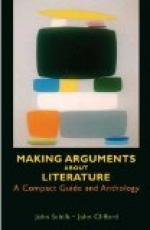* * * * *
I have already suggested that in dealing with these three hypotheses, in endeavoring to form a judgment as to which of them is the more worthy of belief, or whether none is worthy of belief—in which case our condition of mind should be that suspension of judgment which is so difficult to all but trained intellects,—we should be indifferent to all a priori considerations. The question is a question of historical fact. The universe has come into existence somehow or other, and the problem is, whether it came into existence in one fashion, or whether it came into existence in another; and, as an essential preliminary to further discussion, permit me to say two or three words as to the nature and the kinds of historical evidence.
The evidence as to the occurrence of any event in past time may be ranged under two heads, which, for convenience’ sake, I will speak of as testimonial evidence and as circumstantial evidence. By testimonial evidence I mean human testimony; and by circumstantial evidence I mean evidence which is not human testimony. Let me illustrate by a familiar example what I understand by these two kinds of evidence, and what is to be said respecting their value.
Suppose that a man tells you that he saw a person strike another and kill him; that is testimonial evidence of the fact of murder. But it is possible to have circumstantial evidence of the fact of murder; that is to say, you may find a man dying with a wound upon his head having exactly the form and character of the wound which is made by an ax, and, with due care in taking surrounding circumstances into account, you may conclude with the utmost certainty that the man has been murdered; that his death is the consequence of a blow inflicted by another man with that implement. We are very much in the habit of considering circumstantial evidence as of less value than testimonial evidence, and it may be that, where the circumstances are not perfectly clear and intelligible, it is a dangerous and unsafe kind of evidence; but it must not be forgotten that, in many cases, circumstantial evidence is quite as conclusive as testimonial evidence, and that, not unfrequently, it is a great deal weightier than testimonial evidence. For example, take the case to which I referred just now. The circumstantial evidence may be better and more convincing than the testimonial evidence; for it may be impossible, under the conditions that I have defined, to suppose that the man met his death from any cause but the violent blow of an ax wielded by another man. The circumstantial evidence in favor of a murder having been committed, in that case, is as complete and as convincing as evidence can be. It is evidence which is open to no doubt and to no falsification. But the testimony of a witness is open to multitudinous doubts. He may have been mistaken. He may have been actuated by malice. It has constantly happened that even an accurate man has declared that a thing has happened in this, that, or the other way, when a careful analysis of the circumstantial evidence has shown that it did not happen in that way, but in some other way.




